A Man in Full: An Oral History of Kevin Garnett, the Player Who Changed the NBA
2 posters
Page 1 of 1
 A Man in Full: An Oral History of Kevin Garnett, the Player Who Changed the NBA
A Man in Full: An Oral History of Kevin Garnett, the Player Who Changed the NBA
http://bleacherreport.com/articles/2421236-a-man-in-full-the-many-sides-of-kevin-garnett-the-player-who-changed-the-nba
A Man in Full: An Oral History of Kevin Garnett, the Player Who Changed the NBA
By Howard Beck , NBA Senior Writer May 18, 2015
A Man in Full: An Oral History of Kevin Garnett, the Player Who Changed the NBARick Bowmer/Associated Press

On a spring day in 1995, the most powerful men in professional basketball gathered in a Chicago gymnasium to see the future of the NBA.
They had come to see a prospect, a teenager who stood nearly seven feet, with the wingspan of a prehistoric bird, who leaped like cheetah and ran like a gazelle. He looked like a center, but moved like a point guard. Gangly, yet graceful. He could pass and run and shoot. He could guard all five positions.
Until that day, no one had ever seen anything quite like him. Before them stood a basketball player for a new age: Kevin Garnett, The First of His Kind.
Here was a big man who could rise to defend the rim, grab the rebound, lead the fast break and dunk at the other end.
Here was a high school student daring to turn pro, at a time when the draft was strictly populated by collegians.
Here was an audacious, uniquely skilled young man who would, quite literally, change the NBA forever.
The preps-to-pros trend? Garnett started it. The age limit? Garnett indirectly triggered it. The max contract? The five-year rookie scale? The 1998-99 lockout? All were influenced by Garnett's then-infamous $126 million contract.
The perpetual search for lanky, long-limbed, uber-athletes who can swing from the paint to the perimeter—Darius Miles, Stromile Swift, Anthony Randolph—effectively began with Garnett, 20 years ago.
As Garnett's brilliant career quietly winds down back where it all began, in Minnesota—after stops in Boston and Brooklyn—it seems like the right time to reflect on one of the most unique figures ever to grace the NBA.
B/R spoke to more than 40 people who played or worked with Garnett over the course of his basketball life for a two-part oral history of a unique NBA career.
It's easy to forget now—in an era dominated by versatile, physical freaks like LeBron James, Kevin Durant and Anthony Davis, in an era of positionless basketball, where 7-footers shoot threes and freely roam the court—but basketball was, not long ago, seen through a much narrower prism.
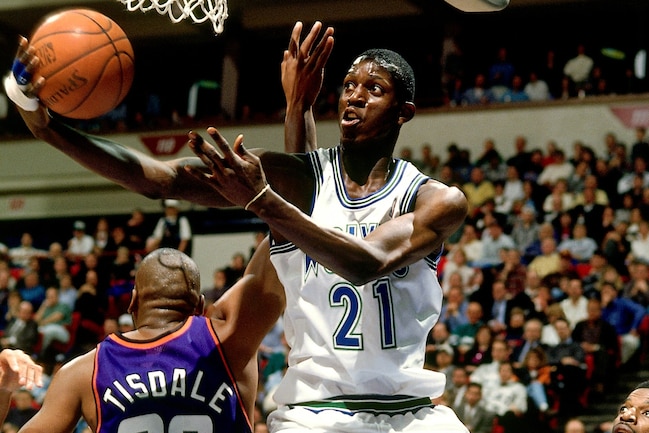
Dale Tait/Getty Images
Power forwards were bruisers like Charles Oakley. Seven-footers like Hakeem Olajuwon lived in the paint. The long-range shooting and ball-handling were left to the little guys. The NBA in 1995 was ruled by muscular inside scorers—Olajuwon, Shaquille O'Neal, David Robinson, Karl Malone, Patrick Ewing, Charles Barkley.
Then along came this spindly, fiery 19-year-old with the height of O'Neal and the grace of Scottie Pippen.
"I think back then, you started to think about how big, how tall these guys were with those skills, and is that going to be the norm?" Gregg Popovich says, recalling Garnett's arrival. "Are we going to have more guys like this come along that can do that? That's what I thought of when I first saw him. It was incredible."
Others would soon stretch our imaginations and definitions—Dirk Nowitzki, Rasheed Wallace and eventually James—but none who were quite like Garnett.
"He was that new-generation, transcendent player at the time," says Paul Pierce, who played against and later with Garnett. "Because nobody saw nothing like that, the combination of speed, athletic ability, versatility at the time. He was the first."
Today, no one blinks when Chris Bosh steps out to shoot a three-pointer, or DeMarcus Cousins pushes the ball in transition. We marvel at Durant and Davis, but Garnett was the prototype, their historical forebear.
"He was kind of the first freak athlete like that, that could move and run and do all those things," says Toronto coach Dwane Casey.
"He revolutionized the sport," Bosh, the Miami Heat star, says of Garnett, without hyperbole. "He was a young fella, being an All-Star, taking the rebound and pushing it down court and finishing with a dunk. I had never seen that before. So I was like, 'If I want to be in the NBA, I've got to do that.'"
Garnett turns 39 Tuesday, and though his ferocity has not faded, his skills most surely have. He may play another season or two, but he has likely played his last truly meaningful game.
Yet Garnett has left an indelible mark—as a pioneer and a prototype, a trash-talker and a barrier-smasher, a leader and a champion.
The Workout
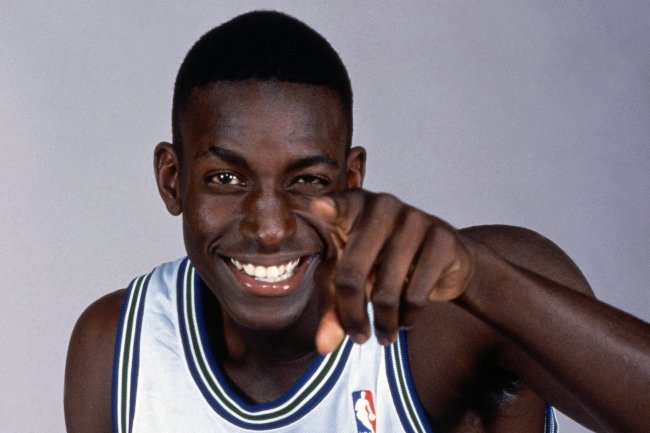
Dale Tait/Getty Images
In a pre-YouTube era, Kevin Garnett was largely a mystery, a high school legend known only to scouting services and AAU coaches. Few had seen him play. NBA executives got their first, and only, up-close look at the Chicago workout.
John Hammond—then an assistant coach for the Detroit Pistons—ran the one-on-none workout, at the request of Garnett's agent, Eric Fleisher.
The top prospects in the 1995 draft were all college studs—Maryland's Joe Smith, Alabama's Antonio McDyess, and North Carolina teammates Rasheed Wallace and Jerry Stackhouse, all sophomores with rich resumes. There was little doubt they would be the first names called on draft night.
Like everyone else, Timberwolves officials—vice president Kevin McHale and general manager Flip Saunders—were hoping to land one of the proven college stars. But Minnesota had the fifth pick, behind Golden State (No. 1), the Los Angeles Clippers (2), the Philadelphia 76ers (3) and the Washington Bullets (4).
John Nash, Bullets general manager, 1990-96: I'm not sure how I felt at that point about a high school kid. But I wanted to do my due diligence. I probably went in a tad negative about taking a high school kid.
Jerry Zgoda, reporter, Minneapolis Star-Tribune: The story Flip tells is, him and McHale go in there saying, 'OK, whatever happens, we're going to praise the hell out of Garnett, and say he's great,' because they wanted either Joe Smith, Stackhouse, McDyess or Rasheed to fall to them.
John Hammond, Bucks GM: The thing that I remember vividly was how nervous Kevin was. He got to the point early in the workout where basically he almost started hyperventilating. I thought he was going to pass out.…So he and I just walked to the other end of the court, with no one on that end. Now we have our backs to everyone. I just had him start shooting some free throws and tried to get him to relax and pull himself back together.
John Nash: The one-on-none workouts can be very misleading. You prefer to have someone out there going against him.…John worked him hard.
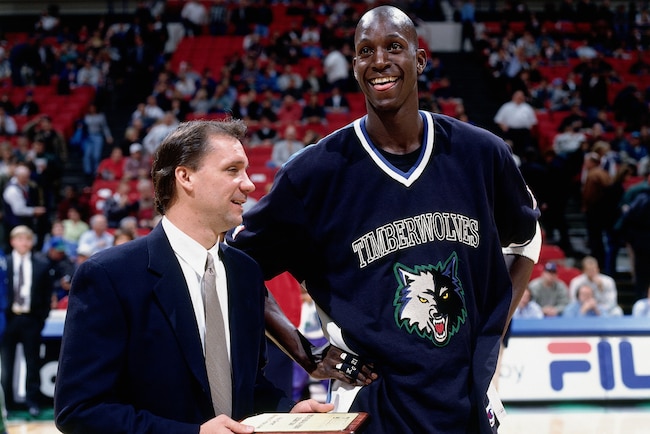
Andy Hayt/Getty Images
John Hammond: Near the very end of the workout, I put him at half court, on the right side of the court. I said, 'Kevin, OK, put the ball on the floor as creatively as you can, and then finish to the basket as strong as you can.' He started putting the ball on the floor, and going behind his back, between his legs, and the speed and the agility that he was doing it with, and then the way he finished at the basket.…I had vision of everybody watching him. And I'm telling you, eyes were wide open and some jaws were dropping.
Flip Saunders, Timberwolves coach, 1995-2005, 2014-Present: His intensity, his energy, his skill set, everything he did was off the charts. If you would have just brought in 10 guys, the top 10 guys, and you just would have let them play and go through things, you would have said, 'OK, we're taking him No. 1.'
John Nash: I came away from the workout going, 'Wow, this guy's going to be a great player,' and came back to Washington and huddled with our owner (Abe Pollin). I explained to him that we liked a lot of players at the top of that draft—Joe Smith and McDyess, and Stackhouse and Rasheed. I said, 'You know, Mr. Pollin, there's this high school kid. I want to tell you, he might be special.' He said, 'John, that's OK, I would prefer it if we didn't draft somebody right out of high school.' I said, 'Mr. Pollin, you're making my job easier, because I would have wrestled with the decision.'
Flip Saunders: That was probably the best workout I've ever seen one individual ever have.…Kevin [McHale] and I both thought that there was no risk. We were just hoping that he was going to be there.
Jerry Zgoda: [On] draft day, somebody called me up at, like, 11 in the morning. I don’t know if it was another team, or if it was an agent, but some guy called and said, 'I got a scoop for you'—he wouldn't identify who he was—that Garnett won't play in Minnesota, he's told the Wolves he won't play there. I remember calling Flip that morning, asking, 'Has Garnett told you he's not going to play there?' He goes, 'Ahhh that’s bullshit.' I don't know who it was.…I never knew.
Preps Pioneer
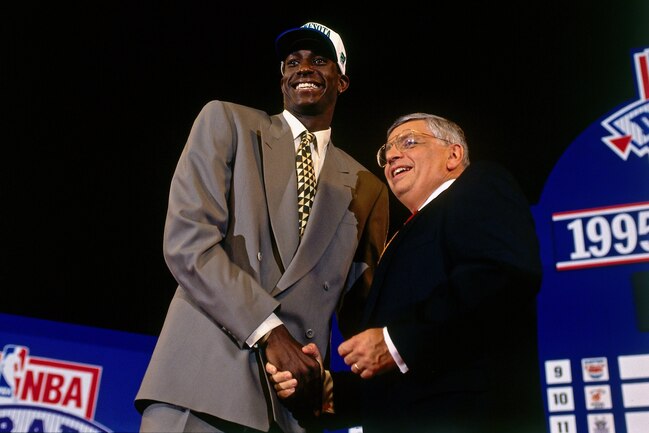
Andrew D. Bernstein/Getty Images
In declaring for the 1995 draft, Garnett became the first teenager in two decades to make the preps-to-pros leap, since Darryl Dawkins and Bill Willoughby in 1975. But once Garnett made the transition, the floodgates swung open. In 1996, preps stars Kobe Bryant, Jermaine O'Neal and Taj McDavid followed Garnett's lead. The trend reached its peak in 2001, with three of the top four draft picks coming straight from high school, including Kwame Brown, the first preps star to be taken No. 1. Two more preps stars would eventually go No. 1: LeBron James in 2003 and Dwight Howard in 2004.
While Garnett, Bryant and Tracy McGrady became superstars, many others washed out, driving league officials to seek a policy change. In 2005, the NBA—with the consent of the players association—adopted a rule requiring all draft entrants to be at least 19 years old and a year removed from high school. All told, 38 players made the preps-to-pros leap in the 10 years following Garnett's entry.
Russ Granik, NBA deputy commissioner 1990-2006: Back when Kevin did it, I think it was looked at as just an anomaly.…I don't think people thought that one player doing this was going to change anything. We hadn't seen a player do it for [20 years]. So he might have been the only one to come in the next 15 years.
John Nash: I think [Garnett and Bryant] coming back to back, and having the success that they had, probably convinced everybody that if they were good enough, they could do it.
Sonny Vaccaro, former sneaker company executive: He may or may not admit to this, but he was going to go to Michigan. The Fab Five guys, that whole era, Juwan Howard being from Chicago—I would've bet a million dollars that's what he was going to do. [But then] I started hearing rumors that he would be drafted high, but [teams] didn't specifically say they would take him.
I said, 'Kevin, if you can’t play, if you screw up, you're still going to get $15 million. God forbid if something happened to you in college, you're not getting anything. He said, 'Mr. Vaccaro, do you think I'll get drafted?'
I told him I didn’t know for sure, but, and I'm paraphrasing—'Kevin, you will not go below 10th in the draft.'
Paul Pierce, Washington Wizards forward (formerly with the Nets and Celtics): He opened the floodgates. There are a lot of guys who are in the league because of that. Who knows if we have Lakers Kobe or LeBron James, these guys out of high school, if it wasn't for Kevin Garnett.
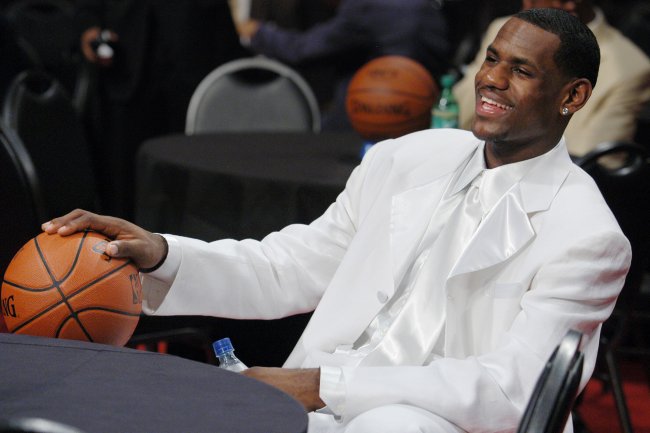
ED BETZ/Associated Press
LeBron James, No. 1 pick in 2003: For myself, KG and Kobe, they set the tone on guys coming straight to the league at that era, in the '90s where it was not the thing to do. In KG's fashion, for him being an 18-year-old kid…to do the things that he did, it was a positive reinforcement when I got to my decision time, that I could do it.
Russ Granik: It got to point where if a high school player didn't come out directly to the NBA, it was almost like he was acknowledging he wasn't a top-tier player. And that really became part of the problem.
Jonathan Abrams, author of "Boys Among Men: How the Prep to Pro Generation Redefined the NBA and Sparked a Basketball Revolution," due out in 2016: I think Kevin Garnett made it almost look a little too easy. He had his growing pains at the beginning, but he really flourished in his second season, so it put it into the heads of a lot of these other guys, that 'Hey, Kevin Garnett did this; maybe I can, too.' But I don't think they really saw the behind-the-scenes work that a young Kevin Garnett really put into his game, and also the veteran leadership that he had on that team, with a guy like Sam Mitchell.
Paul Pierce: After that draft, you noticed that everybody wanted the next Kevin Garnett. They were looking for the tall, skinny kid, who was fast, athletic and trying to bill him as a Kevin Garnett. Guys like Darius Miles, Stromile Swift, Brandan Wright. Keon Clark.…We got these tall, skinny, athletic guys, who are fast, get up and down the court, maybe we can turn them into the next Kevin Garnett. So that's when the draft changed from being full-grown and proven, to OK, this guy has potential, he can be the next Garnett.
Jonathan Abrams: [NBA officials] thought that a couple failures would kind of correct the system, and kids wouldn't jump out of high school. So they weren't that concerned when Garnett originally came out about an influx of high-schoolers applying for the draft in subsequent seasons.
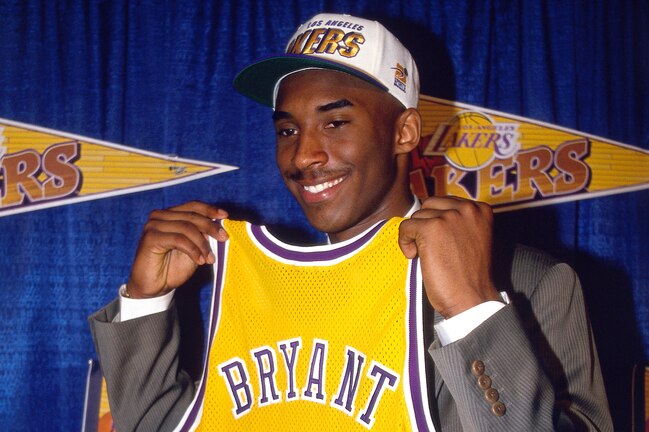
Juan Ocampo/Getty Images
Russ Granik: The problem was when it became much, much more widespread, it became awful hard to evaluate talent. I think that really pushed the league to fight so hard for at least one year out of high school, as the draft eligibility. That one, I really do attribute to [Garnett].
Ron Klempner, NBPA general counsel: [Garnett] was one of the first, and certainly one of the highest profile. I would say that it added to the discussion [of an age limit]. But considering the removal of time, I'm not sure how big of a part it was.
Mr. Intensity
Ask for lasting impressions of Kevin Garnett, and you will quickly find yourself drowning in sports cliches. Focus. Dedication. Loyalty. Team guy. Lots of heart. Also, intense. Really, really intense. Oozing intensity. Did we mention the intensity?
Nearly everyone who has played, coached or competed against Garnett does, frequently.
"He had that right from the beginning—he was always extremely intense," says Saunders, Garnett's coach for his first 10 seasons.
"Every day," says former teammate Sam Mitchell. "Practice or game, you could not tell the difference."
The gritted teeth, the searing gaze, the growling and yapping and exulting, the game-day rituals he followed religiously, the Rain Man-like head-banging on the basket stanchion, the attention to detail, the insistence on every teammate doing his part—this is what players and coaches will remember most.
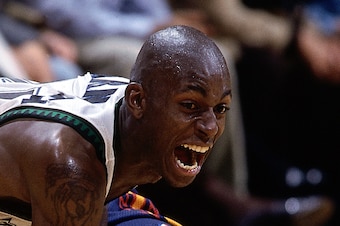
David Sherman/Getty Images
Every first encounter with Garnett is a little different. But no one walks away without a lasting impression.
Paul Pierce: Me and KG played together; I think it was the summer going into my junior year….It was a local AAU team in California….I knew he was one of the top players, but I wasn't sure what kind of player he was at the time. I just knew he was, like, seven feet, 6'11".
Our first practice was at my high school…and I'm watching him run up and down the court, block everybody's shot, yelling, shooting threes, coming down, pushing the ball full court. I was like, man, I ain't never seen nothing like this before. And then all of a sudden, the gym was all filled up and everybody was in there watching him….Every time he blocked a shot, he screamed to the top of his lungs, or dunked and he's yelling as loud as he could. I was just looking like, 'Man, this dude is intense.' If you didn't match his intensity, then he didn't want you out there.
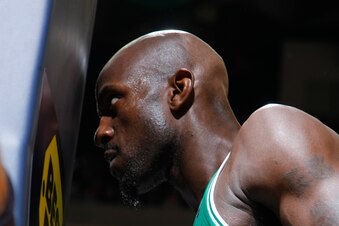
Rocky Widner/Getty Images
Joe Abunassar, Garnett's personal trainer: We had been working out and we went to Memorial Park (in L.A.), and he had forgotten his socks. It was him, [Chauncey] Billups, [Al] Harrington, Ty Lue, Michael Ruffin and a few others. He played every game. He was dunking on guys and blocking shots—all with no socks on. Hours he was playing. When it was over, there was blood seeping through the front of his shoes. Part of his feet and toes were just bleeding. It was unbelievable.
Dirk Nowitzki, Dallas Mavericks forward, 1998-present: My rookie year, he always kind of went at me a little bit. He was talking some crap out there. But that was fun for me, that was my first time really experiencing that. In Germany, nobody ever really talked to me like that. I think that actually helped me in a way, to kind of grow up in this league.
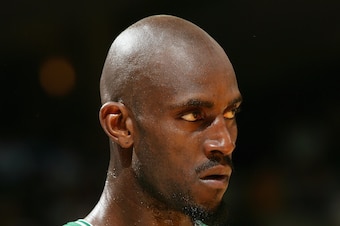
Rocky Widner/Getty Images
Chris Webber, NBA forward, 1993-2008: He and I agreed never to be cool on the court.…He wasn't a fake rah-rah guy. An actor, a liar, can't do that much. To cuss yourself out that much isn't possible.
Christian Laettner, Timberwolves teammate, 1995-96: The thing I recognized immediately, more than anything, besides his freakishly long body, was how much heart he had, and how tough he was for being a young, skinny kid. And I immediately fell in love with him because the kid was so tough. The biggest guy on the team could back him down in the lane, and Kevin was still there ready to fight and bump and to play defense.
Sam Mitchell, Timberwolves teammate, 1995-2002: We were running sprints after practice. He outran every guard, outran every small forward and every big guy. He wanted to win at everything that he did. Every drill, he wanted to win. And it was the first day.…The first thing I thought about was, 'Hell, how am I gonna score against this guy every day in practice?'
Terry Porter, Timberwolves guard, 1995-98: He always had questions: 'What was it like back in the day? What was it like going to the Finals? What was this guy like to play against?' He wanted to know so much about the history of the game and wanted to be great. He always asked, 'What can I do to improve my game?'
Glen Taylor, Timberwolves owner: He said, 'I want to spend time with you,' because, he added, 'There's a whole world that I don't know about.' And I said, 'For what?' 'Well, how do you know when people ask you for money that it's a good charity?' So that's how we spent our first meetings together. He came down to my home sometimes and we sat there and we talked about no basketball.…We just talked about the other parts of life and kind of expanding his life. I'm thinking, 'He's 18 years old, and he's already thinking about this.'
Flip Saunders: Great memory—remembers everything. There have been times where he's remembered scouting reports from six years ago. We always had a fine system for [not returning] scouting reports. In his first few years, he used to just pay all the fines up front, because he would keep the scouting reports to study them in the offseason.
Kevin McHale, Timberwolves GM 1995-2008: He was prone to frustration at times, but there were also glimpses of spectacular play. There were times he [would] block shots, run down the floor, get offensive rebounds, come back down, switch on the guard, keep him in front of him, go back in and help and weak-side block another shot. He had absolute flashes of just brilliance.
Sam Mitchell: First day. Doug West, myself, we knew first day. I remember walking off the court, we looked at each other and said, 'One day, we're going to tell people we played with Kevin Garnett.'
Fans, reporters and opponents soon noticed something else, too: Garnett could not be classified under any conventional NBA rubric, especially on defense. On any given night, he might guard a center, a power forward or a point guard, using his length and quickness to disrupt the shorter players, and his strength and height to bother the bigger guys.
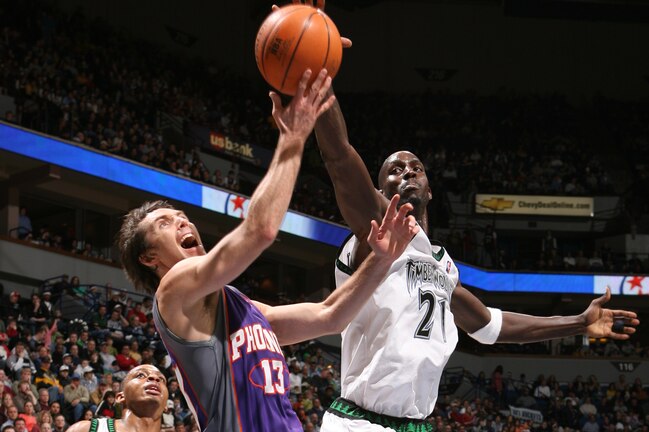
David Sherman/Getty Images
Flip Saunders: He's guarded Michael [Jordan] at times. He's guarded Karl Malone. He's guarded Shaquille [O'Neal]. He's guarded point guards, Kevin Johnson, [Steve] Nash, [Stephon] Marbury. You just pick the All-Stars, at some point he was going to be matched up on all those guys and guard them all. There have been times when he's guarded all five positions in the same game.
Sam Cassell, former Garnett teammate, 2003-2005: Who else could do that? He studied the game. He prepared himself for games better than anybody I saw.
Sam Mitchell: When we played zone he was at the top. His responsibility was to guard the top, front the post and get back to the top. And he did it.
Kevin Johnson, three-time All-Star point guard: I had been guarded by much taller players before, like Magic Johnson, but trying to get around Kevin Garnett seemed impossible. His arms almost stretched from sideline to sideline, he was as quick as a cat, and when you tried to take it to the rim he was able to swat everything. On top of that, he had unlimited energy and effort, and he never stopped talking. Luckily, I didn't have to face him too often, because by the time he hit his prime, my time in the league was winding down.
Jose Calderon, 10-year veteran point guard: People think, 'Oh you're switched to a big guy, just try to play against him, you'll be faster or whatever.' But he was fast at the same time. He was long as well. So even if you passed by him, it was tough to finish, because he was coming from behind to block that shot either way.…He could contest your shot or just go for the block. He was really faster than any other big.
Paul Pierce: I think I was on pace for about 60 points one game. He was guarding Antoine Walker at the time. It was like, 'All right, forget it, Paul's killing us.' So he switched off and guarded me. And I promise you, for a good two-minute stretch, he did not let me catch the ball. I didn't know what to do.…I just stood at halfcourt. I was like, 'All right, as long as he's out of the paint.'
New Age Stockton-Malone
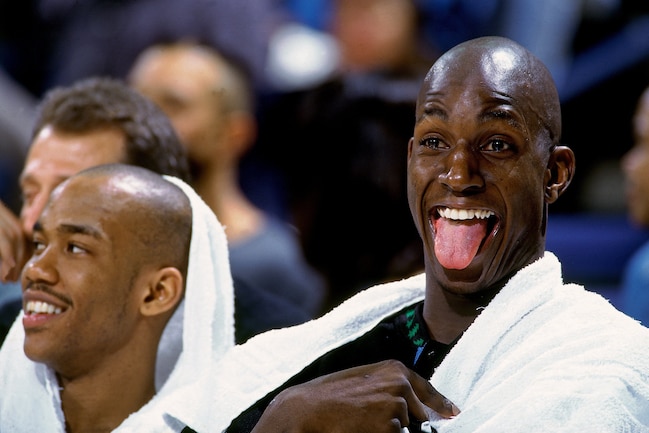
Sam Forencich/Getty Images
One year after drafting Garnett, the Timberwolves made another bold move, executing a draft-day trade for Stephon Marbury, a surly young point guard from Coney Island who had the strength, speed and skills to become a star. The Timberwolves sent Ray Allen, the fifth pick in the 1996 draft, to Milwaukee, for the rights to Marbury, who was taken fourth. The potency of a Marbury-Garnett pairing had Timberwolves officials giddy, and had pundits everywhere gushing about a new-age "Stockton-Malone"—alluding to the Utah Jazz's legendary point guard-power forward duo. With a 20-year-old Garnett and a 19-year-old Marbury, along with talented young forward Tom Gugliotta, the Timberwolves appeared to be set for years to come, a Western Conference power in the making.
Sam Mitchell: Oh, they were good, man. You put those two in the pick-and-roll, it was over. Because Steph could flat-out score, and he was strong and he could get to the basket. And Steph had an assh--e streak in him that you've gotta have. Oh, he had it in him. The great ones gotta have that in them.
Flip Saunders: KG, to this day, is probably one of the best screen-setters. KG can pick and pop and score, he can score at the rim. Steph was like a blur coming off screens. He had the ability to shoot from behind. They became, at times, pretty much unguardable.
Sam Mitchell: Maybe even better [than Stockton-Malone], because Steph was so much more of a scorer than John Stockton was. And Steph could facilitate, just like Stockton, but Steph was just so much more a dominant scorer than Stockton.
Steve Aschburner, Timberwolves beat writer for Minneapolis Star-Tribune, 1994-2007: From the outside, they seemed to be best buds. They did commercials together and appearances locally together.
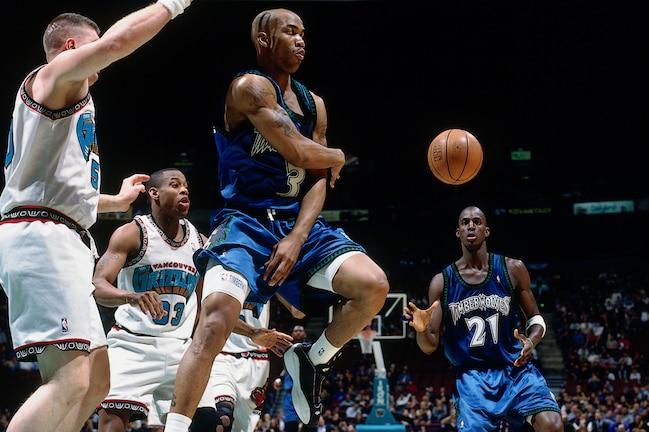
Andy Hayt/Getty Images
Jim LaBumbard, Timberwolves media relations executive, 1993-2000: [Marbury] was so excited to be coming to Minnesota, and for us in Minnesota that was a breath of fresh air, too. No one was excited to come to Minnesota at that point, right? So we thought that was pretty cool.
With Garnett averaging 17 points, Marbury 15.8 points and Gugliotta 20.6 points, the Timberwolves won 40 games in 1996-97 and made the playoffs for the first time in the franchise's eight-year history. They were swept in the first round, 3-0, by Hakeem Olajuwon and the Houston Rockets. The following year, Garnett and Marbury helped set a then-franchise mark with 45 wins, but fell in the first round to the Seattle SuperSonics, 3-2. It would be their last playoff run as Timberwolves teammates.
Marbury forced a trade in 1999 to the New Jersey Nets—a move that was said to be motivated in part by Marbury's jealousy over Garnett's $126 million, six-year contract extension. Under the NBA's new labor deal, which capped individual salaries, the most Marbury could earn was $71 million over six years.
Flip Saunders: We got double-whammied. KG's contract forced the lockout. And by that contract, the lockout forced the [max] contract. And so we lost Marbury, because basically Marbury thought he couldn't play with KG when he was making $20 million, and Steph was making $9 million, and Steph was taking shots at the end of the game. That was his quote.

David Sherman/Getty Images
Steve Aschburner: Garnett, his favorite player was Magic Johnson. He would have been happy facilitating Marbury's game. That wasn't going to be an issue, in terms of sharing the ball or anything. Ultimately, I think it was money that got in Stephon's head, and the notion that he'd have to go make it bigger somewhere else.
Terry Porter: He felt he was, if not 1a, [then] 1b, and he should at least be in that ballpark (financially). He didn't feel at that point that they valued what he brought to the table.
Sam Mitchell: We all wanted Steph here. But sometimes these guys when they're young, man, they have outside influences that we just can't compete with.…They all want the same thing: They all want to get paid, they all want to be an All-Star, and they all want to be 'the man.'
Flip Saunders: I knew we were in trouble, the year we [acquired] Marbury. I said something to Stephon about, 'You guys can be like Stockton and Malone.' And he said, 'Well I don't want to be John Stockton.' We were trying to convince him that it's the two guys together, the greatness that they could have. He didn't want that.
The Contract, The Lockout
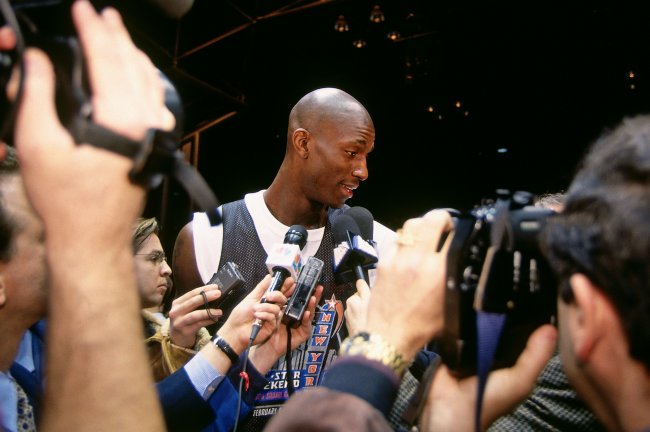
NBA Photos/Getty Images
Garnett was just 21 years old, and two years into his NBA career, when he signed what was then the richest contract in pro sports history: $126 million over six years. The deal, signed in October 1997, triggered fierce skepticism and derision, even among other NBA players.
"He is on the hit list," an unnamed player told the Miami Herald at the time. Although Garnett made the All-Star team in his second season, he was not yet a superstar and had yet to win a playoff game. Yet the value of his contract was more than double what Michael Jordan had earned in his career to that point. The price tag for Garnett was nearly $40 million more than the price Glen Taylor paid to purchase the team just two years earlier.
Other stars had recently signed groundbreaking deals: Shaquille O'Neal, $120 million; Alonzo Mourning, $101 million; Juwan Howard, $105 million. But it was Garnett's deal that owners cited as proof of a broken system. The following summer, the NBA locked out its players, beginning the longest work stoppage in NBA history, a six-month standoff that lasted until January 20, 1999. The NBA played a 50-game season that year but canceled the All-Star Game.
Although there were other factors, Garnett's contract is often cited as having triggered the lockout.
Glen Taylor: I think it did.
Russ Granik: I certainly wouldn't blame the lockout that occurred in '98-99 on Mr. Garnett. We always had the view that a player was entitled to get whatever he was able to get under the system. But I think the extent of his contract led a lot of people in the league to feel that it proved that the current salary cap wasn't working that well anymore, and that some changes had to take place. If it wasn't his contract, it would have been the next contract that was signed.
Ron Klempner, NBPA general counsel: Coming out of the 1995 [CBA negotiations], the owners clearly did not get what they wanted, and they were looking for the first available opportunity to be able to go back in and get it. Garnett's contract provided them with all of the ammunition that they needed.
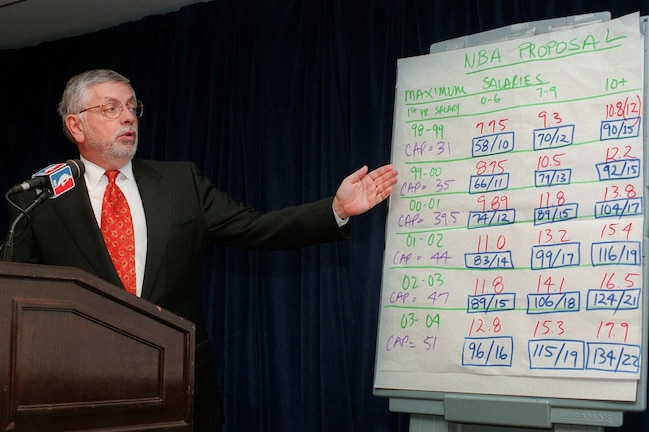
MITCH JACOBSON/Associated Press
Andy Miller, Garnett's agent since 1995: It was sort of an unfair target.…With lot of the small-market teams at the time, and the old-school owners, the Glen Taylors of the world, I think they used that as a little bit of a weapon to gain an advantage.
Ron Klempner: The concept of young players, just two years removed from high school, being able to sign for guaranteed amounts of that magnitude, was certainly a factor that permeated the negotiations.
Glen Taylor: I thought some of the big markets would be after [Garnett]....And my thoughts were, the franchise had been down, down, down. This is the first time the fans in Minnesota could see some hope. So I went out there and made an investment that probably, money-wise, business-wise, was not a good one. But it had to do more with, that I lived here, I was a Minnesotan, and I wanted this for our team.
The collective bargaining agreement reached in 1999 clearly reflected the concerns over Garnett's contract. The new CBA included, for the first time, a maximum player salary, as well as a five-year rookie scale (up from three years)—two features that would have prevented any team from handing a $126 million deal to a second-year player.
Ron Klempner: It soon became clear that the owners wanted a longer period by which they could control the incoming players. It's safe to say that both of those rule changes can be traced back in one way or another to the Garnett contract.
Russ Granik: I don't think those things were all related just to his contract.…There were a number of players who had begun a trend of starting to demand renegotiations and possible trades very early in a player's career. So I don't think that was attributable particularly to Kevin. It certainly was an example of the concern.
Agent Provocateur
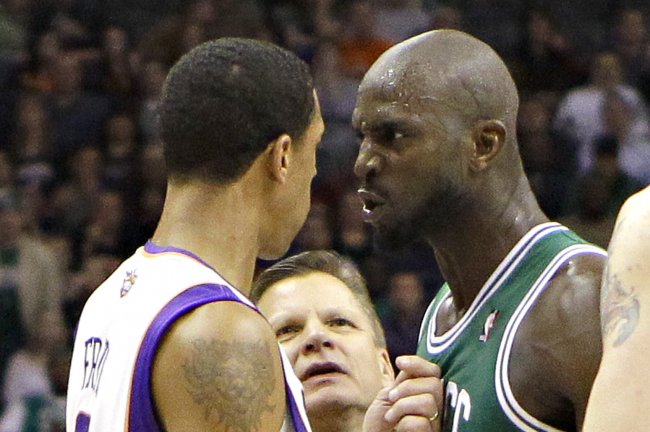
Matt York/Associated Press
Trash talking was well-ingrained in the game when Kevin Garnett arrived, but he's taken the art of provocation to new places—and occasionally over the lines of common decency, according to some of his targets over the years.
It's not just the creative taunts that set Garnett apart. He barks and chirps almost incessantly, in games and practice. He bellows, he chest thumps, he points, he claps, he glares. The verbal imbroglios are both legendary and infamous.
Such as the time Garnett (then with Boston) switched onto point guard Jose Calderon (then with Toronto) and spent two straight possessions yammering at him. Or the time Garnett roughed up the Phoenix Suns' Channing Frye, causing then-Suns coach Alvin Gentry to remark, "I lost a little respect for him." Or the time Garnett allegedly called Charlie Villanueva—who suffers from alopecia universalis, a disease that causes a loss of body hair—"a cancer patient" (an incident confirmed by Villanueva). Or the time he reportedly made an untoward remark about Carmelo Anthony's wife (an allegation that's never been confirmed). Or the time he threateningly grabbed the neck of the Knicks' Bill (now Henry) Walker—a former Celtics teammate—after the final buzzer.
Occasionally—very occasionally—Garnett drops the ferocity long enough to laugh at himself.
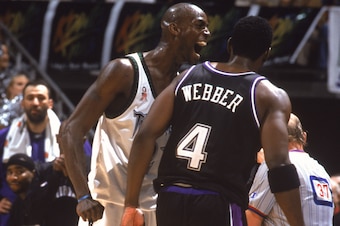
David Sherman/Getty Images
Sam Mitchell: Most of that stuff he's saying is to himself. It's funny, people think he's talking trash, but he's on himself about mistakes. If you listen to him, he's always talking about 'Kevin this,' 'Kevin that,' 'Kevin, what the 'F' you doing?'
Flip Saunders: It's his shtick. Have there been times we've talked to him and tried to have him calm down? Yeah. But that's just kind of who he is. If you're on the other team, you are the enemy.
Phil Jackson: He carried himself with a tremendous amount of, what would you call it, bravado. High bravado. I had had some of my players tell me, 'It's all show; it's not go,' that bravado. 'Don't worry about him, he's not gonna do anything. He's just gonna talk big.'…He's talked a lot of crap over his career.
Flip Saunders: Kevin's not a fighter. He's a lover. You always worry about it a little bit. He's got a very unique ability to be able to know when he's gone too far, when to cut things off.
Henry Walker, former Celtic and Knick: That thing [between us] happened, we were coming out of the tunnel. I was with my mother and my sister and my daughter. I walked up to him, and I asked, 'Hey, what's going on?' because 'You know, you're like [one of] my guys I looked up to.' He just apologized. It was no big deal, man.
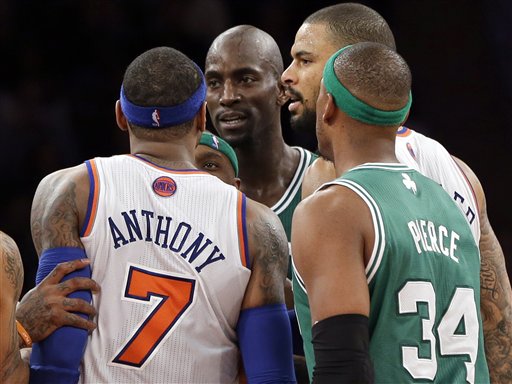
Kathy Willens/Associated Press
Sam Cassell: He's got a Dr. Jekyll and Mr. Hyde thing. Off the court, he's a great person. Great conversation. But on the court, he becomes a maniac. If you don't have that [same] colored jersey he has on, you're against him.
Steve Aschburner: In the preseason (in Garnett's rookie year), they played against Milwaukee, they also played against the Lakers. I know that he took guff from Cedric Ceballos and from Glenn Robinson. One of them said something like, 'He's not ready,' as he sort of shoved Garnett out of bounds. And the other one was also trash-talking Garnett. He didn't curl up in the fetal position. He sort of gave [it] back verbally, but mostly he just went on playing. That stuck with me, that this guy, he's got some spine to him. He's not gonna get rattled here.
Dwane Casey: The same trash talk he did during the game, he did during practice.…You couldn't print most of it. It was never malicious. It was just something to get in the other guy's head.

Noah Graham/Getty Images
Alvin Gentry, Suns head coach, 2009-13: He's always been an edgy guy, that's what made him great.…I wouldn't judge him by that [one incident with Frye]. At the time, as a coach, it's something you're obviously going to react to.…There's Michael Jordan, there's Kobe and then, from a competitive standpoint, he'd have to be at that next tier.
Zach Randolph, NBA forward, 2001-present: We're always trash talking. I fouled him when I played for Portland—he was playing for Minnesota—he fell, but then did five push-ups in a row before he got up.
Chris Bosh, NBA forward, 2003-present: Usually I don't talk back, but if he said something to me, I said something back. I had just a terrible game for me (against the Celtics in the 2011 playoffs). He got me all off my game. He scored, like, four times in a row on me in the crunch. And I was so embarrassed and so upset, and he got in my head. Ever since that day, I never said anything else.
Jose Calderon: Everything started because I switched (onto Garnett on defense) once, and I contested one of his shots. And he made it. So he was kind of happy about it. So we went at each other.…The next possession he comes back and he's like, 'OK, let's do it again.'…I think after that, he looked at me differently, like, I stood up to him or whatever. After that, we have [had] a great relationship.
Danny Ainge, Celtics GM: He's so competitive that he wanted to win that scrimmage in practice, and he wanted his players to be able to talk through the trash. It was real. It wasn't just some sort of contrived test on his players. He genuinely wanted to compete and he wanted to win in practice, and he was not afraid of challenging his players and talking trash to them and getting them fired up.
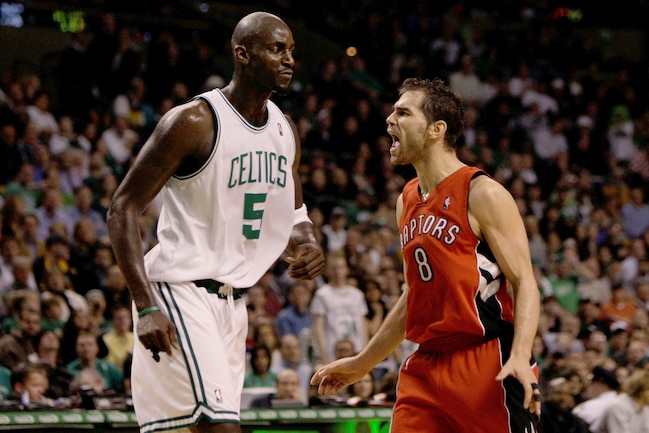
Charles Krupa/Associated Press
Tony Allen, Celtics teammate, 2007-10: (In practice), I'd make a shot, he'd be like, some explicit version of 'Do it again! Bring that (bleep) in here again!' Or they'll score, they'll make a run and he'll scream, out something like, 'I'm not good, I'm great!' His motor just never stops.
Paul Pierce: One time, he asked [Joakim] Noah if he could rub through his hair, like a female or something.…And I know that kind of made [Noah] hot. And this was when Noah was a rookie, too. I remember Noah looked up to KG. He was like, 'Man, KG, I had your poster on my wall, I looked up to you, man.' And then [Garnett] just said something like that, and was like 'F--- you, Noah.' I was like, 'Whoa.' This kid fresh out of college, looks up to KG, just said he had his poster on the wall, and he tells him that! It crushed him. It crushed Noah.
Kendrick Perkins, Celtics teammates 2007-11: He definitely has the best punch lines in the NBA, as far as talking goes. You don't really want to wrassle with Ticket. He got the best vocab, for sure.
Paul Pierce, recalling a light moment between himself (then with Boston) and Garnett (then with Minnesota): We were both on losing teams at this point. This is probably around the last week of the season. We're talking (trash) at the free-throw line. I'm like, 'Man, everybody needs to shut up, because we all going to the Bahamas next week.' And as intense as he was, he had to look up and just start laughing.…I said, 'I'm going to Cancun. Where are you going, Ticket?' He said, 'I'm going to St. Lucia.'
bob
.
A Man in Full: An Oral History of Kevin Garnett, the Player Who Changed the NBA
By Howard Beck , NBA Senior Writer May 18, 2015
A Man in Full: An Oral History of Kevin Garnett, the Player Who Changed the NBARick Bowmer/Associated Press

On a spring day in 1995, the most powerful men in professional basketball gathered in a Chicago gymnasium to see the future of the NBA.
They had come to see a prospect, a teenager who stood nearly seven feet, with the wingspan of a prehistoric bird, who leaped like cheetah and ran like a gazelle. He looked like a center, but moved like a point guard. Gangly, yet graceful. He could pass and run and shoot. He could guard all five positions.
Until that day, no one had ever seen anything quite like him. Before them stood a basketball player for a new age: Kevin Garnett, The First of His Kind.
Here was a big man who could rise to defend the rim, grab the rebound, lead the fast break and dunk at the other end.
Here was a high school student daring to turn pro, at a time when the draft was strictly populated by collegians.
Here was an audacious, uniquely skilled young man who would, quite literally, change the NBA forever.
The preps-to-pros trend? Garnett started it. The age limit? Garnett indirectly triggered it. The max contract? The five-year rookie scale? The 1998-99 lockout? All were influenced by Garnett's then-infamous $126 million contract.
The perpetual search for lanky, long-limbed, uber-athletes who can swing from the paint to the perimeter—Darius Miles, Stromile Swift, Anthony Randolph—effectively began with Garnett, 20 years ago.
As Garnett's brilliant career quietly winds down back where it all began, in Minnesota—after stops in Boston and Brooklyn—it seems like the right time to reflect on one of the most unique figures ever to grace the NBA.
B/R spoke to more than 40 people who played or worked with Garnett over the course of his basketball life for a two-part oral history of a unique NBA career.
It's easy to forget now—in an era dominated by versatile, physical freaks like LeBron James, Kevin Durant and Anthony Davis, in an era of positionless basketball, where 7-footers shoot threes and freely roam the court—but basketball was, not long ago, seen through a much narrower prism.

Dale Tait/Getty Images
Power forwards were bruisers like Charles Oakley. Seven-footers like Hakeem Olajuwon lived in the paint. The long-range shooting and ball-handling were left to the little guys. The NBA in 1995 was ruled by muscular inside scorers—Olajuwon, Shaquille O'Neal, David Robinson, Karl Malone, Patrick Ewing, Charles Barkley.
Then along came this spindly, fiery 19-year-old with the height of O'Neal and the grace of Scottie Pippen.
"I think back then, you started to think about how big, how tall these guys were with those skills, and is that going to be the norm?" Gregg Popovich says, recalling Garnett's arrival. "Are we going to have more guys like this come along that can do that? That's what I thought of when I first saw him. It was incredible."
Others would soon stretch our imaginations and definitions—Dirk Nowitzki, Rasheed Wallace and eventually James—but none who were quite like Garnett.
"He was that new-generation, transcendent player at the time," says Paul Pierce, who played against and later with Garnett. "Because nobody saw nothing like that, the combination of speed, athletic ability, versatility at the time. He was the first."
Today, no one blinks when Chris Bosh steps out to shoot a three-pointer, or DeMarcus Cousins pushes the ball in transition. We marvel at Durant and Davis, but Garnett was the prototype, their historical forebear.
"He was kind of the first freak athlete like that, that could move and run and do all those things," says Toronto coach Dwane Casey.
"He revolutionized the sport," Bosh, the Miami Heat star, says of Garnett, without hyperbole. "He was a young fella, being an All-Star, taking the rebound and pushing it down court and finishing with a dunk. I had never seen that before. So I was like, 'If I want to be in the NBA, I've got to do that.'"
Garnett turns 39 Tuesday, and though his ferocity has not faded, his skills most surely have. He may play another season or two, but he has likely played his last truly meaningful game.
Yet Garnett has left an indelible mark—as a pioneer and a prototype, a trash-talker and a barrier-smasher, a leader and a champion.
The Workout

Dale Tait/Getty Images
In a pre-YouTube era, Kevin Garnett was largely a mystery, a high school legend known only to scouting services and AAU coaches. Few had seen him play. NBA executives got their first, and only, up-close look at the Chicago workout.
John Hammond—then an assistant coach for the Detroit Pistons—ran the one-on-none workout, at the request of Garnett's agent, Eric Fleisher.
The top prospects in the 1995 draft were all college studs—Maryland's Joe Smith, Alabama's Antonio McDyess, and North Carolina teammates Rasheed Wallace and Jerry Stackhouse, all sophomores with rich resumes. There was little doubt they would be the first names called on draft night.
Like everyone else, Timberwolves officials—vice president Kevin McHale and general manager Flip Saunders—were hoping to land one of the proven college stars. But Minnesota had the fifth pick, behind Golden State (No. 1), the Los Angeles Clippers (2), the Philadelphia 76ers (3) and the Washington Bullets (4).
John Nash, Bullets general manager, 1990-96: I'm not sure how I felt at that point about a high school kid. But I wanted to do my due diligence. I probably went in a tad negative about taking a high school kid.
Jerry Zgoda, reporter, Minneapolis Star-Tribune: The story Flip tells is, him and McHale go in there saying, 'OK, whatever happens, we're going to praise the hell out of Garnett, and say he's great,' because they wanted either Joe Smith, Stackhouse, McDyess or Rasheed to fall to them.
John Hammond, Bucks GM: The thing that I remember vividly was how nervous Kevin was. He got to the point early in the workout where basically he almost started hyperventilating. I thought he was going to pass out.…So he and I just walked to the other end of the court, with no one on that end. Now we have our backs to everyone. I just had him start shooting some free throws and tried to get him to relax and pull himself back together.
John Nash: The one-on-none workouts can be very misleading. You prefer to have someone out there going against him.…John worked him hard.

Andy Hayt/Getty Images
John Hammond: Near the very end of the workout, I put him at half court, on the right side of the court. I said, 'Kevin, OK, put the ball on the floor as creatively as you can, and then finish to the basket as strong as you can.' He started putting the ball on the floor, and going behind his back, between his legs, and the speed and the agility that he was doing it with, and then the way he finished at the basket.…I had vision of everybody watching him. And I'm telling you, eyes were wide open and some jaws were dropping.
Flip Saunders, Timberwolves coach, 1995-2005, 2014-Present: His intensity, his energy, his skill set, everything he did was off the charts. If you would have just brought in 10 guys, the top 10 guys, and you just would have let them play and go through things, you would have said, 'OK, we're taking him No. 1.'
John Nash: I came away from the workout going, 'Wow, this guy's going to be a great player,' and came back to Washington and huddled with our owner (Abe Pollin). I explained to him that we liked a lot of players at the top of that draft—Joe Smith and McDyess, and Stackhouse and Rasheed. I said, 'You know, Mr. Pollin, there's this high school kid. I want to tell you, he might be special.' He said, 'John, that's OK, I would prefer it if we didn't draft somebody right out of high school.' I said, 'Mr. Pollin, you're making my job easier, because I would have wrestled with the decision.'
Flip Saunders: That was probably the best workout I've ever seen one individual ever have.…Kevin [McHale] and I both thought that there was no risk. We were just hoping that he was going to be there.
Jerry Zgoda: [On] draft day, somebody called me up at, like, 11 in the morning. I don’t know if it was another team, or if it was an agent, but some guy called and said, 'I got a scoop for you'—he wouldn't identify who he was—that Garnett won't play in Minnesota, he's told the Wolves he won't play there. I remember calling Flip that morning, asking, 'Has Garnett told you he's not going to play there?' He goes, 'Ahhh that’s bullshit.' I don't know who it was.…I never knew.
Preps Pioneer

Andrew D. Bernstein/Getty Images
In declaring for the 1995 draft, Garnett became the first teenager in two decades to make the preps-to-pros leap, since Darryl Dawkins and Bill Willoughby in 1975. But once Garnett made the transition, the floodgates swung open. In 1996, preps stars Kobe Bryant, Jermaine O'Neal and Taj McDavid followed Garnett's lead. The trend reached its peak in 2001, with three of the top four draft picks coming straight from high school, including Kwame Brown, the first preps star to be taken No. 1. Two more preps stars would eventually go No. 1: LeBron James in 2003 and Dwight Howard in 2004.
While Garnett, Bryant and Tracy McGrady became superstars, many others washed out, driving league officials to seek a policy change. In 2005, the NBA—with the consent of the players association—adopted a rule requiring all draft entrants to be at least 19 years old and a year removed from high school. All told, 38 players made the preps-to-pros leap in the 10 years following Garnett's entry.
Russ Granik, NBA deputy commissioner 1990-2006: Back when Kevin did it, I think it was looked at as just an anomaly.…I don't think people thought that one player doing this was going to change anything. We hadn't seen a player do it for [20 years]. So he might have been the only one to come in the next 15 years.
John Nash: I think [Garnett and Bryant] coming back to back, and having the success that they had, probably convinced everybody that if they were good enough, they could do it.
Sonny Vaccaro, former sneaker company executive: He may or may not admit to this, but he was going to go to Michigan. The Fab Five guys, that whole era, Juwan Howard being from Chicago—I would've bet a million dollars that's what he was going to do. [But then] I started hearing rumors that he would be drafted high, but [teams] didn't specifically say they would take him.
I said, 'Kevin, if you can’t play, if you screw up, you're still going to get $15 million. God forbid if something happened to you in college, you're not getting anything. He said, 'Mr. Vaccaro, do you think I'll get drafted?'
I told him I didn’t know for sure, but, and I'm paraphrasing—'Kevin, you will not go below 10th in the draft.'
Paul Pierce, Washington Wizards forward (formerly with the Nets and Celtics): He opened the floodgates. There are a lot of guys who are in the league because of that. Who knows if we have Lakers Kobe or LeBron James, these guys out of high school, if it wasn't for Kevin Garnett.

ED BETZ/Associated Press
LeBron James, No. 1 pick in 2003: For myself, KG and Kobe, they set the tone on guys coming straight to the league at that era, in the '90s where it was not the thing to do. In KG's fashion, for him being an 18-year-old kid…to do the things that he did, it was a positive reinforcement when I got to my decision time, that I could do it.
Russ Granik: It got to point where if a high school player didn't come out directly to the NBA, it was almost like he was acknowledging he wasn't a top-tier player. And that really became part of the problem.
Jonathan Abrams, author of "Boys Among Men: How the Prep to Pro Generation Redefined the NBA and Sparked a Basketball Revolution," due out in 2016: I think Kevin Garnett made it almost look a little too easy. He had his growing pains at the beginning, but he really flourished in his second season, so it put it into the heads of a lot of these other guys, that 'Hey, Kevin Garnett did this; maybe I can, too.' But I don't think they really saw the behind-the-scenes work that a young Kevin Garnett really put into his game, and also the veteran leadership that he had on that team, with a guy like Sam Mitchell.
Paul Pierce: After that draft, you noticed that everybody wanted the next Kevin Garnett. They were looking for the tall, skinny kid, who was fast, athletic and trying to bill him as a Kevin Garnett. Guys like Darius Miles, Stromile Swift, Brandan Wright. Keon Clark.…We got these tall, skinny, athletic guys, who are fast, get up and down the court, maybe we can turn them into the next Kevin Garnett. So that's when the draft changed from being full-grown and proven, to OK, this guy has potential, he can be the next Garnett.
Jonathan Abrams: [NBA officials] thought that a couple failures would kind of correct the system, and kids wouldn't jump out of high school. So they weren't that concerned when Garnett originally came out about an influx of high-schoolers applying for the draft in subsequent seasons.

Juan Ocampo/Getty Images
Russ Granik: The problem was when it became much, much more widespread, it became awful hard to evaluate talent. I think that really pushed the league to fight so hard for at least one year out of high school, as the draft eligibility. That one, I really do attribute to [Garnett].
Ron Klempner, NBPA general counsel: [Garnett] was one of the first, and certainly one of the highest profile. I would say that it added to the discussion [of an age limit]. But considering the removal of time, I'm not sure how big of a part it was.
Mr. Intensity
Ask for lasting impressions of Kevin Garnett, and you will quickly find yourself drowning in sports cliches. Focus. Dedication. Loyalty. Team guy. Lots of heart. Also, intense. Really, really intense. Oozing intensity. Did we mention the intensity?
Nearly everyone who has played, coached or competed against Garnett does, frequently.
"He had that right from the beginning—he was always extremely intense," says Saunders, Garnett's coach for his first 10 seasons.
"Every day," says former teammate Sam Mitchell. "Practice or game, you could not tell the difference."
The gritted teeth, the searing gaze, the growling and yapping and exulting, the game-day rituals he followed religiously, the Rain Man-like head-banging on the basket stanchion, the attention to detail, the insistence on every teammate doing his part—this is what players and coaches will remember most.

David Sherman/Getty Images
Every first encounter with Garnett is a little different. But no one walks away without a lasting impression.
Paul Pierce: Me and KG played together; I think it was the summer going into my junior year….It was a local AAU team in California….I knew he was one of the top players, but I wasn't sure what kind of player he was at the time. I just knew he was, like, seven feet, 6'11".
Our first practice was at my high school…and I'm watching him run up and down the court, block everybody's shot, yelling, shooting threes, coming down, pushing the ball full court. I was like, man, I ain't never seen nothing like this before. And then all of a sudden, the gym was all filled up and everybody was in there watching him….Every time he blocked a shot, he screamed to the top of his lungs, or dunked and he's yelling as loud as he could. I was just looking like, 'Man, this dude is intense.' If you didn't match his intensity, then he didn't want you out there.

Rocky Widner/Getty Images
Joe Abunassar, Garnett's personal trainer: We had been working out and we went to Memorial Park (in L.A.), and he had forgotten his socks. It was him, [Chauncey] Billups, [Al] Harrington, Ty Lue, Michael Ruffin and a few others. He played every game. He was dunking on guys and blocking shots—all with no socks on. Hours he was playing. When it was over, there was blood seeping through the front of his shoes. Part of his feet and toes were just bleeding. It was unbelievable.
Dirk Nowitzki, Dallas Mavericks forward, 1998-present: My rookie year, he always kind of went at me a little bit. He was talking some crap out there. But that was fun for me, that was my first time really experiencing that. In Germany, nobody ever really talked to me like that. I think that actually helped me in a way, to kind of grow up in this league.

Rocky Widner/Getty Images
Chris Webber, NBA forward, 1993-2008: He and I agreed never to be cool on the court.…He wasn't a fake rah-rah guy. An actor, a liar, can't do that much. To cuss yourself out that much isn't possible.
Christian Laettner, Timberwolves teammate, 1995-96: The thing I recognized immediately, more than anything, besides his freakishly long body, was how much heart he had, and how tough he was for being a young, skinny kid. And I immediately fell in love with him because the kid was so tough. The biggest guy on the team could back him down in the lane, and Kevin was still there ready to fight and bump and to play defense.
Sam Mitchell, Timberwolves teammate, 1995-2002: We were running sprints after practice. He outran every guard, outran every small forward and every big guy. He wanted to win at everything that he did. Every drill, he wanted to win. And it was the first day.…The first thing I thought about was, 'Hell, how am I gonna score against this guy every day in practice?'
Terry Porter, Timberwolves guard, 1995-98: He always had questions: 'What was it like back in the day? What was it like going to the Finals? What was this guy like to play against?' He wanted to know so much about the history of the game and wanted to be great. He always asked, 'What can I do to improve my game?'
Glen Taylor, Timberwolves owner: He said, 'I want to spend time with you,' because, he added, 'There's a whole world that I don't know about.' And I said, 'For what?' 'Well, how do you know when people ask you for money that it's a good charity?' So that's how we spent our first meetings together. He came down to my home sometimes and we sat there and we talked about no basketball.…We just talked about the other parts of life and kind of expanding his life. I'm thinking, 'He's 18 years old, and he's already thinking about this.'
Flip Saunders: Great memory—remembers everything. There have been times where he's remembered scouting reports from six years ago. We always had a fine system for [not returning] scouting reports. In his first few years, he used to just pay all the fines up front, because he would keep the scouting reports to study them in the offseason.
Kevin McHale, Timberwolves GM 1995-2008: He was prone to frustration at times, but there were also glimpses of spectacular play. There were times he [would] block shots, run down the floor, get offensive rebounds, come back down, switch on the guard, keep him in front of him, go back in and help and weak-side block another shot. He had absolute flashes of just brilliance.
Sam Mitchell: First day. Doug West, myself, we knew first day. I remember walking off the court, we looked at each other and said, 'One day, we're going to tell people we played with Kevin Garnett.'
Fans, reporters and opponents soon noticed something else, too: Garnett could not be classified under any conventional NBA rubric, especially on defense. On any given night, he might guard a center, a power forward or a point guard, using his length and quickness to disrupt the shorter players, and his strength and height to bother the bigger guys.

David Sherman/Getty Images
Flip Saunders: He's guarded Michael [Jordan] at times. He's guarded Karl Malone. He's guarded Shaquille [O'Neal]. He's guarded point guards, Kevin Johnson, [Steve] Nash, [Stephon] Marbury. You just pick the All-Stars, at some point he was going to be matched up on all those guys and guard them all. There have been times when he's guarded all five positions in the same game.
Sam Cassell, former Garnett teammate, 2003-2005: Who else could do that? He studied the game. He prepared himself for games better than anybody I saw.
Sam Mitchell: When we played zone he was at the top. His responsibility was to guard the top, front the post and get back to the top. And he did it.
Kevin Johnson, three-time All-Star point guard: I had been guarded by much taller players before, like Magic Johnson, but trying to get around Kevin Garnett seemed impossible. His arms almost stretched from sideline to sideline, he was as quick as a cat, and when you tried to take it to the rim he was able to swat everything. On top of that, he had unlimited energy and effort, and he never stopped talking. Luckily, I didn't have to face him too often, because by the time he hit his prime, my time in the league was winding down.
Jose Calderon, 10-year veteran point guard: People think, 'Oh you're switched to a big guy, just try to play against him, you'll be faster or whatever.' But he was fast at the same time. He was long as well. So even if you passed by him, it was tough to finish, because he was coming from behind to block that shot either way.…He could contest your shot or just go for the block. He was really faster than any other big.
Paul Pierce: I think I was on pace for about 60 points one game. He was guarding Antoine Walker at the time. It was like, 'All right, forget it, Paul's killing us.' So he switched off and guarded me. And I promise you, for a good two-minute stretch, he did not let me catch the ball. I didn't know what to do.…I just stood at halfcourt. I was like, 'All right, as long as he's out of the paint.'
New Age Stockton-Malone

Sam Forencich/Getty Images
One year after drafting Garnett, the Timberwolves made another bold move, executing a draft-day trade for Stephon Marbury, a surly young point guard from Coney Island who had the strength, speed and skills to become a star. The Timberwolves sent Ray Allen, the fifth pick in the 1996 draft, to Milwaukee, for the rights to Marbury, who was taken fourth. The potency of a Marbury-Garnett pairing had Timberwolves officials giddy, and had pundits everywhere gushing about a new-age "Stockton-Malone"—alluding to the Utah Jazz's legendary point guard-power forward duo. With a 20-year-old Garnett and a 19-year-old Marbury, along with talented young forward Tom Gugliotta, the Timberwolves appeared to be set for years to come, a Western Conference power in the making.
Sam Mitchell: Oh, they were good, man. You put those two in the pick-and-roll, it was over. Because Steph could flat-out score, and he was strong and he could get to the basket. And Steph had an assh--e streak in him that you've gotta have. Oh, he had it in him. The great ones gotta have that in them.
Flip Saunders: KG, to this day, is probably one of the best screen-setters. KG can pick and pop and score, he can score at the rim. Steph was like a blur coming off screens. He had the ability to shoot from behind. They became, at times, pretty much unguardable.
Sam Mitchell: Maybe even better [than Stockton-Malone], because Steph was so much more of a scorer than John Stockton was. And Steph could facilitate, just like Stockton, but Steph was just so much more a dominant scorer than Stockton.
Steve Aschburner, Timberwolves beat writer for Minneapolis Star-Tribune, 1994-2007: From the outside, they seemed to be best buds. They did commercials together and appearances locally together.

Andy Hayt/Getty Images
Jim LaBumbard, Timberwolves media relations executive, 1993-2000: [Marbury] was so excited to be coming to Minnesota, and for us in Minnesota that was a breath of fresh air, too. No one was excited to come to Minnesota at that point, right? So we thought that was pretty cool.
With Garnett averaging 17 points, Marbury 15.8 points and Gugliotta 20.6 points, the Timberwolves won 40 games in 1996-97 and made the playoffs for the first time in the franchise's eight-year history. They were swept in the first round, 3-0, by Hakeem Olajuwon and the Houston Rockets. The following year, Garnett and Marbury helped set a then-franchise mark with 45 wins, but fell in the first round to the Seattle SuperSonics, 3-2. It would be their last playoff run as Timberwolves teammates.
Marbury forced a trade in 1999 to the New Jersey Nets—a move that was said to be motivated in part by Marbury's jealousy over Garnett's $126 million, six-year contract extension. Under the NBA's new labor deal, which capped individual salaries, the most Marbury could earn was $71 million over six years.
Flip Saunders: We got double-whammied. KG's contract forced the lockout. And by that contract, the lockout forced the [max] contract. And so we lost Marbury, because basically Marbury thought he couldn't play with KG when he was making $20 million, and Steph was making $9 million, and Steph was taking shots at the end of the game. That was his quote.

David Sherman/Getty Images
Steve Aschburner: Garnett, his favorite player was Magic Johnson. He would have been happy facilitating Marbury's game. That wasn't going to be an issue, in terms of sharing the ball or anything. Ultimately, I think it was money that got in Stephon's head, and the notion that he'd have to go make it bigger somewhere else.
Terry Porter: He felt he was, if not 1a, [then] 1b, and he should at least be in that ballpark (financially). He didn't feel at that point that they valued what he brought to the table.
Sam Mitchell: We all wanted Steph here. But sometimes these guys when they're young, man, they have outside influences that we just can't compete with.…They all want the same thing: They all want to get paid, they all want to be an All-Star, and they all want to be 'the man.'
Flip Saunders: I knew we were in trouble, the year we [acquired] Marbury. I said something to Stephon about, 'You guys can be like Stockton and Malone.' And he said, 'Well I don't want to be John Stockton.' We were trying to convince him that it's the two guys together, the greatness that they could have. He didn't want that.
The Contract, The Lockout

NBA Photos/Getty Images
Garnett was just 21 years old, and two years into his NBA career, when he signed what was then the richest contract in pro sports history: $126 million over six years. The deal, signed in October 1997, triggered fierce skepticism and derision, even among other NBA players.
"He is on the hit list," an unnamed player told the Miami Herald at the time. Although Garnett made the All-Star team in his second season, he was not yet a superstar and had yet to win a playoff game. Yet the value of his contract was more than double what Michael Jordan had earned in his career to that point. The price tag for Garnett was nearly $40 million more than the price Glen Taylor paid to purchase the team just two years earlier.
Other stars had recently signed groundbreaking deals: Shaquille O'Neal, $120 million; Alonzo Mourning, $101 million; Juwan Howard, $105 million. But it was Garnett's deal that owners cited as proof of a broken system. The following summer, the NBA locked out its players, beginning the longest work stoppage in NBA history, a six-month standoff that lasted until January 20, 1999. The NBA played a 50-game season that year but canceled the All-Star Game.
Although there were other factors, Garnett's contract is often cited as having triggered the lockout.
Glen Taylor: I think it did.
Russ Granik: I certainly wouldn't blame the lockout that occurred in '98-99 on Mr. Garnett. We always had the view that a player was entitled to get whatever he was able to get under the system. But I think the extent of his contract led a lot of people in the league to feel that it proved that the current salary cap wasn't working that well anymore, and that some changes had to take place. If it wasn't his contract, it would have been the next contract that was signed.
Ron Klempner, NBPA general counsel: Coming out of the 1995 [CBA negotiations], the owners clearly did not get what they wanted, and they were looking for the first available opportunity to be able to go back in and get it. Garnett's contract provided them with all of the ammunition that they needed.

MITCH JACOBSON/Associated Press
Andy Miller, Garnett's agent since 1995: It was sort of an unfair target.…With lot of the small-market teams at the time, and the old-school owners, the Glen Taylors of the world, I think they used that as a little bit of a weapon to gain an advantage.
Ron Klempner: The concept of young players, just two years removed from high school, being able to sign for guaranteed amounts of that magnitude, was certainly a factor that permeated the negotiations.
Glen Taylor: I thought some of the big markets would be after [Garnett]....And my thoughts were, the franchise had been down, down, down. This is the first time the fans in Minnesota could see some hope. So I went out there and made an investment that probably, money-wise, business-wise, was not a good one. But it had to do more with, that I lived here, I was a Minnesotan, and I wanted this for our team.
The collective bargaining agreement reached in 1999 clearly reflected the concerns over Garnett's contract. The new CBA included, for the first time, a maximum player salary, as well as a five-year rookie scale (up from three years)—two features that would have prevented any team from handing a $126 million deal to a second-year player.
Ron Klempner: It soon became clear that the owners wanted a longer period by which they could control the incoming players. It's safe to say that both of those rule changes can be traced back in one way or another to the Garnett contract.
Russ Granik: I don't think those things were all related just to his contract.…There were a number of players who had begun a trend of starting to demand renegotiations and possible trades very early in a player's career. So I don't think that was attributable particularly to Kevin. It certainly was an example of the concern.
Agent Provocateur

Matt York/Associated Press
Trash talking was well-ingrained in the game when Kevin Garnett arrived, but he's taken the art of provocation to new places—and occasionally over the lines of common decency, according to some of his targets over the years.
It's not just the creative taunts that set Garnett apart. He barks and chirps almost incessantly, in games and practice. He bellows, he chest thumps, he points, he claps, he glares. The verbal imbroglios are both legendary and infamous.
Such as the time Garnett (then with Boston) switched onto point guard Jose Calderon (then with Toronto) and spent two straight possessions yammering at him. Or the time Garnett roughed up the Phoenix Suns' Channing Frye, causing then-Suns coach Alvin Gentry to remark, "I lost a little respect for him." Or the time Garnett allegedly called Charlie Villanueva—who suffers from alopecia universalis, a disease that causes a loss of body hair—"a cancer patient" (an incident confirmed by Villanueva). Or the time he reportedly made an untoward remark about Carmelo Anthony's wife (an allegation that's never been confirmed). Or the time he threateningly grabbed the neck of the Knicks' Bill (now Henry) Walker—a former Celtics teammate—after the final buzzer.
Occasionally—very occasionally—Garnett drops the ferocity long enough to laugh at himself.

David Sherman/Getty Images
Sam Mitchell: Most of that stuff he's saying is to himself. It's funny, people think he's talking trash, but he's on himself about mistakes. If you listen to him, he's always talking about 'Kevin this,' 'Kevin that,' 'Kevin, what the 'F' you doing?'
Flip Saunders: It's his shtick. Have there been times we've talked to him and tried to have him calm down? Yeah. But that's just kind of who he is. If you're on the other team, you are the enemy.
Phil Jackson: He carried himself with a tremendous amount of, what would you call it, bravado. High bravado. I had had some of my players tell me, 'It's all show; it's not go,' that bravado. 'Don't worry about him, he's not gonna do anything. He's just gonna talk big.'…He's talked a lot of crap over his career.
Flip Saunders: Kevin's not a fighter. He's a lover. You always worry about it a little bit. He's got a very unique ability to be able to know when he's gone too far, when to cut things off.
Henry Walker, former Celtic and Knick: That thing [between us] happened, we were coming out of the tunnel. I was with my mother and my sister and my daughter. I walked up to him, and I asked, 'Hey, what's going on?' because 'You know, you're like [one of] my guys I looked up to.' He just apologized. It was no big deal, man.

Kathy Willens/Associated Press
Sam Cassell: He's got a Dr. Jekyll and Mr. Hyde thing. Off the court, he's a great person. Great conversation. But on the court, he becomes a maniac. If you don't have that [same] colored jersey he has on, you're against him.
Steve Aschburner: In the preseason (in Garnett's rookie year), they played against Milwaukee, they also played against the Lakers. I know that he took guff from Cedric Ceballos and from Glenn Robinson. One of them said something like, 'He's not ready,' as he sort of shoved Garnett out of bounds. And the other one was also trash-talking Garnett. He didn't curl up in the fetal position. He sort of gave [it] back verbally, but mostly he just went on playing. That stuck with me, that this guy, he's got some spine to him. He's not gonna get rattled here.
Dwane Casey: The same trash talk he did during the game, he did during practice.…You couldn't print most of it. It was never malicious. It was just something to get in the other guy's head.

Noah Graham/Getty Images
Alvin Gentry, Suns head coach, 2009-13: He's always been an edgy guy, that's what made him great.…I wouldn't judge him by that [one incident with Frye]. At the time, as a coach, it's something you're obviously going to react to.…There's Michael Jordan, there's Kobe and then, from a competitive standpoint, he'd have to be at that next tier.
Zach Randolph, NBA forward, 2001-present: We're always trash talking. I fouled him when I played for Portland—he was playing for Minnesota—he fell, but then did five push-ups in a row before he got up.
Chris Bosh, NBA forward, 2003-present: Usually I don't talk back, but if he said something to me, I said something back. I had just a terrible game for me (against the Celtics in the 2011 playoffs). He got me all off my game. He scored, like, four times in a row on me in the crunch. And I was so embarrassed and so upset, and he got in my head. Ever since that day, I never said anything else.
Jose Calderon: Everything started because I switched (onto Garnett on defense) once, and I contested one of his shots. And he made it. So he was kind of happy about it. So we went at each other.…The next possession he comes back and he's like, 'OK, let's do it again.'…I think after that, he looked at me differently, like, I stood up to him or whatever. After that, we have [had] a great relationship.
Danny Ainge, Celtics GM: He's so competitive that he wanted to win that scrimmage in practice, and he wanted his players to be able to talk through the trash. It was real. It wasn't just some sort of contrived test on his players. He genuinely wanted to compete and he wanted to win in practice, and he was not afraid of challenging his players and talking trash to them and getting them fired up.

Charles Krupa/Associated Press
Tony Allen, Celtics teammate, 2007-10: (In practice), I'd make a shot, he'd be like, some explicit version of 'Do it again! Bring that (bleep) in here again!' Or they'll score, they'll make a run and he'll scream, out something like, 'I'm not good, I'm great!' His motor just never stops.
Paul Pierce: One time, he asked [Joakim] Noah if he could rub through his hair, like a female or something.…And I know that kind of made [Noah] hot. And this was when Noah was a rookie, too. I remember Noah looked up to KG. He was like, 'Man, KG, I had your poster on my wall, I looked up to you, man.' And then [Garnett] just said something like that, and was like 'F--- you, Noah.' I was like, 'Whoa.' This kid fresh out of college, looks up to KG, just said he had his poster on the wall, and he tells him that! It crushed him. It crushed Noah.
Kendrick Perkins, Celtics teammates 2007-11: He definitely has the best punch lines in the NBA, as far as talking goes. You don't really want to wrassle with Ticket. He got the best vocab, for sure.
Paul Pierce, recalling a light moment between himself (then with Boston) and Garnett (then with Minnesota): We were both on losing teams at this point. This is probably around the last week of the season. We're talking (trash) at the free-throw line. I'm like, 'Man, everybody needs to shut up, because we all going to the Bahamas next week.' And as intense as he was, he had to look up and just start laughing.…I said, 'I'm going to Cancun. Where are you going, Ticket?' He said, 'I'm going to St. Lucia.'
bob
.

bobheckler- Posts : 62620
Join date : 2009-10-28
 Re: A Man in Full: An Oral History of Kevin Garnett, the Player Who Changed the NBA
Re: A Man in Full: An Oral History of Kevin Garnett, the Player Who Changed the NBA
We need more human interest stories like this one.
Sam
Sam
 Similar topics
Similar topics» Kevin Garnett on Hyenas and History
» Oral History: Kendrick Perkins, the NBA's Best Teammate
» Nique vs. Bird: An Oral History of the NBA's Greatest Playoff Duel
» Double '07: Kevin Garnett, Kevin Love and Celtics Restoration - Part 2
» KG, the Oral History, Part 2: Glory in Boston, Quirky Traits and Returning Home
» Oral History: Kendrick Perkins, the NBA's Best Teammate
» Nique vs. Bird: An Oral History of the NBA's Greatest Playoff Duel
» Double '07: Kevin Garnett, Kevin Love and Celtics Restoration - Part 2
» KG, the Oral History, Part 2: Glory in Boston, Quirky Traits and Returning Home
Page 1 of 1
Permissions in this forum:
You cannot reply to topics in this forum